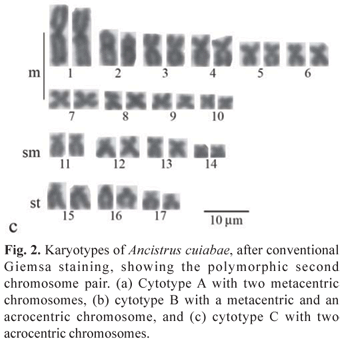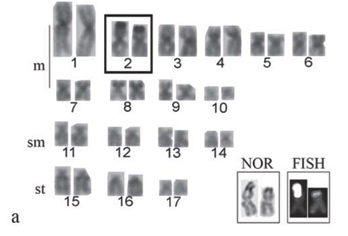Cytogenetic and FISH analyses were performed in 30 Ancistrus cuiabae specimens from a bay near the town of Poconé, in the Pantanal of Mato Grosso, Brazil. The observed diploid number was 2n = 34 chromosomes for both sexes and three distinct katyotypic formulae were found, namely cytotype A (20m, 8sm, 6st, Fundamental Number/FN = 68; 6 males and 11 females), cytotype B (19m, 8sm, 6st, 1a, FN = 67; 8 males and 4 females) and cytotype C (18m, 8sm, 6st, 2a, FN = 66; a single male). NORs's analyses showed that these regions were located in distinct sites on the NOR-bearing chromosome pair, according to cytotypes. Thus, in cytotype A, NORs were located in the terminal region of the short arm of the second metacentric chromosome pair; in cytotype B, they were detected in the short arm of the metacentric chromosome and interstitially on the acrocentric chromosome and, in cytotype C, NORs were observed in the interstitial region of the acrocentric chromosome pair. C-positive heterochromatic bands were adjacent to the rDNA sites in the corresponding chromosomes. Thus, the chromosomal polymorphism of A. cuiabae was probably originated through a pericentric inversion in chromosome pair nº 2 involving the NOR sites, which represents a novelty in the Ancistrini tribe. The results also broaden the knowledge of the chromosomal evolution in Ancistrus, the most derived genus of the Ancistrini tribe.
Cytogenetics; NOR; Pericentric inversion; Chromosomal evolution







